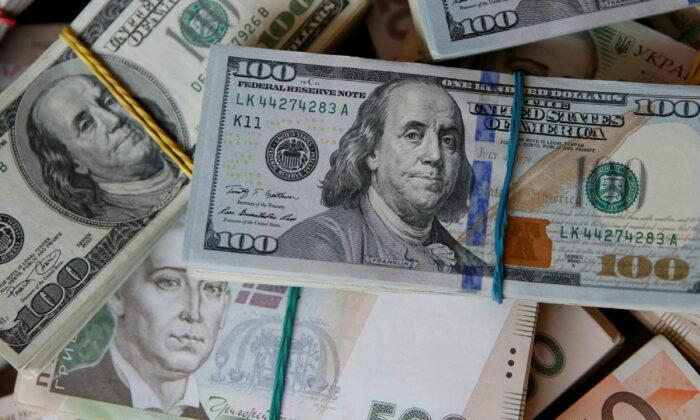SINGAPORE/LONDON—The dollar wavered near a seven-week high on Monday, as investors took stock of last week’s strong economic data and rapid reconsideration of where interest rates will peak.
Data on Friday showed U.S. consumer spending rebounded sharply in January, while inflation accelerated.
Traders now expect the Fed to raise interest rates to around 5.4 percent by the summer, according to pricing in futures markers. At the beginning of February, they envisaged rates rising to a peak of just 4.9 percent.
The euro fell to its lowest level against the dollar since Jan. 6 on Monday as the U.S. currency gained, slipping to $1.053. It then rebounded somewhat and was last up 0.1 percent to $1.055.
The dollar index, which measures it against six major peers, was last down less than 0.1 percent at 105.11, after earlier climbing to a seven-week high of 105.36.
The index is up 3 percent for February and sets to snap a four-month losing streak. Expectations of higher interest rates tend to boost a currency, by making the country’s fixed-income investments look more attractive.
“Whereas headline rates are falling, the trend of rising core inflation rates has been unbroken,” said Ulrich Leuchtmann, head of FX research at Commerzbank.
“Only once we notice a reversal in this data, the fear of inflation currently affecting the market is going to ease.”
Friday’s data showed that the core measure of U.S. personal consumption expenditures inflation, which strips out volatile food and energy costs, came in at 4.7 percent year-on-year in January, up from 4.6 percent in December.
Core consumer price inflation in the eurozone rose to a record high of 5.3 percent year-on-year in January.
The dollar was last steady against the Japanese yen at 136.3 yen, reversing some of its gains after rising to a more than two-month high of 136.58 earlier in the session.
Incoming Bank of Japan Governor Kazuo Ueda said on Monday the merits of the bank’s current monetary policy outweigh the costs, stressing the need to maintain support for the Japanese economy with ultra-low interest rates.
The pound was also flat to $1.1946, after falling for three straight sessions.
Investors will get more information on the state of the global economy this week, with U.S. ISM manufacturing survey data for February due on Wednesday; and preliminary eurozone CPI inflation figures for February due the following day.
“We’re in a bit of a nervous environment,” said Moh Siong Sim, currency strategist at Bank of Singapore, adding that the market is uncertain about the pace of Fed interest rate rises.
“Can (the Fed) maintain 25 basis point hike? Or will they be forced to re-accelerate the pace? So I think these are the questions that the market is grappling with,” Sim said.
The Aussie was 0.08 percent lower at $0.672, after falling below $0.67 to its lowest since early January earlier in the session.





